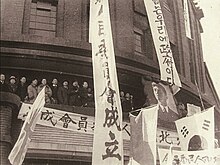|
Provisional People's Committee of North Korea
The Provisional People's Committee of North Korea (Korean: 북조선림시인민위원회) was the provisional government of North Korea. The committee was established on 8 February 1946 in response for the need of the Soviet Civil Administration and the communists to have centralization of power in northern Korea, which was then an area divided into provincial people's committees. Regarded as the highest administrative power institution in northern Korea, it also became a de facto provisional government that carried out reforms, such as land reforms and the nationalization of key industries. The committee was succeeded by the People's Committee of North Korea on 21 February 1947, which became a provisional government as northern Korea transitioned into the Democratic People's Republic of Korea. HistoryWith the surrender of the Empire of Japan in the World War II in August 1945, people's committees were set up throughout Korea. The administration of these people's committees were recognized by the Soviet forces entering northern Korea, while setting up their own occupation authority known as the Soviet Civil Administration on 3 October 1945. An early attempt by the Soviets to create a centralized government in northern Korea was the Administrative Committee of Five Provinces. This was established on 8 October 1945 and was headed by the nationalist and South Pyongan people's committee chairman Cho Man-sik, who was the most prominent figure in northern Korea and one of the Soviets' candidates for a future North Korean leader. This committee was a temporary self-governing institution created by representatives of the five provincial people's committees in northern Korea, which consisted of an alliance between communists and nationalists. The Administrative Committee of Five Provinces ended following the arrest of Cho Man-sik by the Soviets in January 1946 due to opposing ideologies between the two and Cho's opposition to the proposal of the Moscow Conference for a trusteeship in Korea.  On 8–9 February 1946, a meeting of political parties, social organizations, people's committees and administrative bureaus in northern Korea established the Provisional People's Committee of North Korea. This new communist-dominated committee was headed by its chairman Kim Il Sung, a communist being backed by the Soviets to become the North Korean leader. This committee effectively became a de facto provisional government that carried out reforms in northern Korea such as land reforms and nationalization of key industries in accordance to the 20-Point Platform issued by Kim Il Sung in March 1946. The Soviet Civil Administration continued to function concurrently with the Provisional People's Committee of North Korea, but in an advisory role. The Provisional People's Committee of North Korea held local people's committee elections in November 1946. This was in preparation for the election in February 1947 of the People's Assembly of North Korea, which organized the People's Committee of North Korea on 21 February 1947 that became the succeeding provisional government in northern Korea. OrganizationThe Provisional People's Committee of North Korea was organized through a meeting of political parties, social organizations, administrative bureaus and people's committees in northern Korea on 8–9 February 1946. Participating in the meeting were 137 representatives that included two representatives from the Communist Party of Korea, two representatives from the Democratic Party of Korea, two representatives from the Independence Alliance, two representatives from the General Federation of Labor Unions, two representatives from the General Federation of Peasant Unions, one representative from the Women's League, one representative from the Democratic Youth League, one representative from religious associations, one representative from the Korea-Soviet Cultural Association, 11 administrative bureau heads and representatives from the people's committees.[2] Kim Il Sung made a report on the political situation in North Korea and the issue of creating a provisional people's committee on the first day of the meeting on 8 February. This was followed on 9 February by the election of the 23 members of the Provisional People's Committee of North Korea, with Kim Il Sung as chairman, Kim Tu-bong as vice chairman and Kang Ryang-uk as secretary general.[2][3]
The Provisional People's Committee of North Korea also consisted of ten departments and three bureaus (which was later increased to four bureaus).[3]
Han Hui-jin would later be replaced as the head of the transportation department by Ho Nam-hui, and Han Tong-chan being replaced as head of the commerce department by Jang Si-u. O Ki-sop later became the head of the labor department following its creation in September 1946, with Ri Chong-won becoming the new head of the propaganda bureau.[3] ReformsOn 23 March 1946, Kim Il Sung issued the 20-Point Platform, which became the basis of the reforms to be implemented in northern Korea.
On 8 March 1946, land reform was implemented in North Korea that saw the confiscation of land from Japanese nationals and organizations, Korean collaborations, landowners and religious organizations. The confiscated land were then redistributed to 420,000 households. A total of 52% of North Korea's land area and 82% of land ownerships were redistributed.[3] On 24 June 1946, an 8-hour work day was implemented, with workers involved in dangerous work being assigned to a 7-hour work day. Work was prohibited for those who are below the age of 14. Equal pay and social insurance were implemented for workers.[3] On 22 July 1946, a law on gender equality in North Korea was enacted.[3] On 10 August 1946, 1,034 major industrial facilities, or 90% of the total industry in North Korea, were nationalized.[3] On 27 December 1946, it was decided that farmers in North Korea would give 25% of their harvest as agricultural tax.[3] References
|
|||||||||||||||||||||||||||||||||||||||||||||||||||||||||||||||||||||||||||||||||||||||||||||||||||||||||||||||||||||||||||||||||||||||||||||||||||||||


